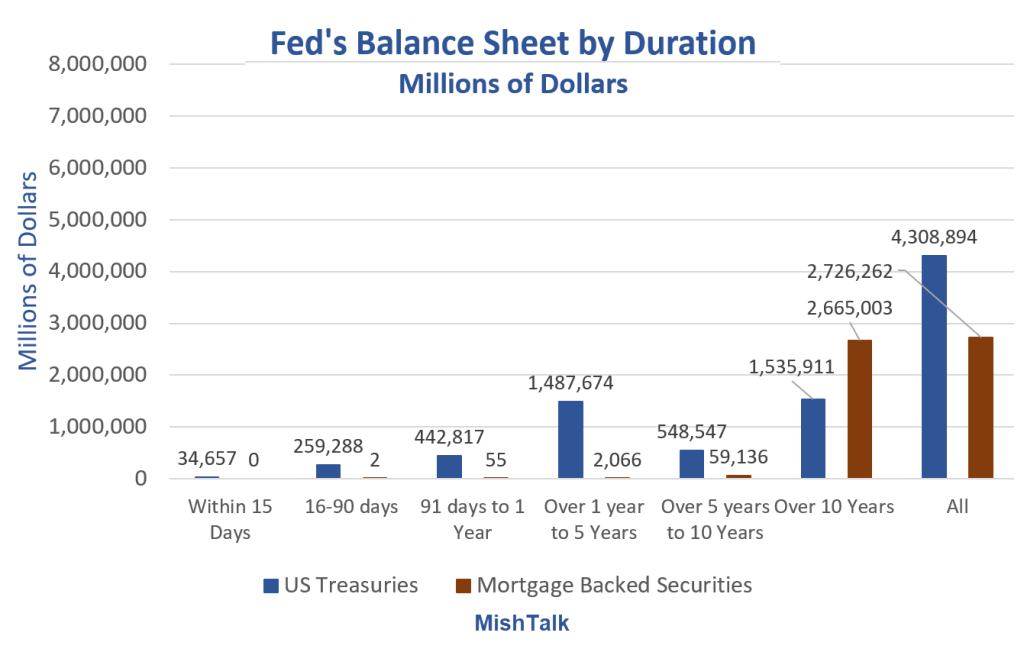Every month since April of 2022 the Fed has been slowly unwinding QE that it should not have done in the first place.

Total Balance Sheet Reduction
Since April 13, 2022 the Fed has reduced its balance sheet from $8.965 trillion to $6.856 trillion.
That’s a reduction of $1.801 trillion in 2.66 years.
The normal level before the Great Recession was about $860 billion.
This balance sheet reduction is called Quantitative Tightening (QT). It’s the opposite of balance sheet expansion called Quantitative Easing (QE).
Reverse Repo Reduction
Reverse repos have fallen from $2.320 trillion to $0.456 trillion. Thus most of the reduction has been in reverse repos.
Mortgage Backed Securities Reduction
Since April 13, 2022 the Fed has reduced its MBS balance sheet from $2.740 trillion to $2.245 trillion.
That’s a reduction of $0.495 trillion in 2.66 years.
This is best described as a joke because the normal Fed holding of MBS is $0.000 trillion.
Fed’s Balance Sheet by Duration

Nearly all of the Fed’s MBS portfolio has a duration of 10 years or greater.
The Fed will not sell MBS outright to stick to its announced schedule because that would pressure mortgage rates higher.
Thus, the Fed portfolio reduction is entirely short term runoffs (of which there is a mere $57 million potential for all of 2025), plus any sales of homes on which the Fed holds the mortgage paper.
Reducing the Runoff
On May 1, 2024, Reuters reported the Fed Announces Reduction in Balance Sheet Runoff Pace.
The Fed said that starting on June 1 it will reduce the cap on Treasury securities it allows to mature and not be replaced to $25 billion from its current cap of up to $60 billion per month. The Fed left the cap on how many mortgage-backed securities it will allow to roll off its books at $35 billion per month, and it will reinvest any excess MBS principal payments into Treasuries.
Federal Reserve Chair Jerome Powell, speaking in a press conference following the Fed meeting, said the new caps would likely result in around $40 billion per month in total balance sheet runoff, alluding to how actual reductions in bonds have frequently fallen short of the caps, notably on the mortgage bond side.
Fed officials have been making the case that by moderating the drawdown pace they reduce the risk of unwanted market disruptions of the sort that occurred when they last shrunk their balance sheet. They’ve also noted that by slowing the pace of balance sheet contraction, it may allow them to reduce the overall size of their holdings by a greater degree.
Powell reiterated those views in his press conference, saying “the decision to slow the pace of runoff does not mean that our balance sheet will ultimately shrink by less than it would otherwise, but rather allows us to approach its ultimate level more gradually,” which reduced the risk of market tumult.
At $35 billion per month since April of 2022, the Fed would have reduced it MBS holding by $35 billion * 32 months which is $1.12 trillion.
It’s MBS reduction is much less than half of that. But the Fed says slower means more. Yeah right.
When Might the Fed End QT?
J.P. Morgan asks When might the Fed end its quantitative tightening (QT) program?
Since May 2022, the Fed has reduced its balance sheet by almost $2 trillion3, and it’s similarly been “like watching paint dry.” However, the Fed and market participants are sensitive to avoid another liquidity scare. As such, investors are curious; what might lead the Fed to end its current QT program and how soon?
The RRP [Reverse Repo] is perceived as a measure of “excess’ liquidity meaning there are more dollars in short term vehicles—primarily money market funds—than there are supply of Treasury bills in the open market, and thus Treasury collateral is provided at the Fed via the RRP. However, as the Fed’s balance sheet continues to shrink, the RRP is well on its way to zero. Given this, a continuation of QT could last another three months without hiccup; thereafter, most of the decline in liquidity is likely to be seen in falling bank reserves.
Importantly, regardless of the direction policy needs to go next year, they can only be successful if the market is functioning as intended. Hence, they should learn from their mistakes in 2019 and consider ending QT a bit earlier especially given fiscal policy uncertainty next year.
Ending QT “a bit earlier” means a balance sheet of close to $7 trillion dollars forever.
Meanwhile, please note Reverse Repos have been stick on exactly $456 billion ever since March 13, 2024. What’s up with that?
Two Recession Indicators, What Do They Say Now?
On December 20, I noted Two Recession Indicators, What Do They Say Now?
A pair of very reliable Indicators still suggest recession.
But will it be a stagflation recession with higher interest rates or will it be a deflationary recession?
How about no recession at all with Trump blasting inflation higher until the Fed acts to force one?
All of the above are possible outcomes.
The Fed projects years ahead when the Fed cannot even see three months ahead.
Dear Fed, Please Shut Up Already, Stop the Forward Guidance
On December 21, I commented Dear Fed, Please Shut Up Already, Stop the Forward Guidance
Danielle DiMartino Booth claims the Fed should be cutting more, not less. I have a different suggestion.
The short version of my suggestion for the Fed is “STFU”.
